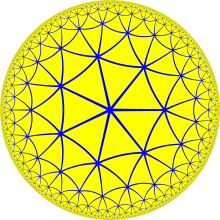Hurwitz surface

In
The
Automorphisms of complex algebraic curves are
A note on terminology – in this and other contexts, the "(2,3,7) triangle group" most often refers, not to the full triangle group Δ(2,3,7) (the
Classification by genus
Only finitely many Hurwitz surfaces occur with each genus. The function mapping the genus to the number of Hurwitz surfaces with that genus is unbounded, even though most of its values are zero. The sum
converges for , implying in an approximate sense that the genus of the th Hurwitz surface grows at least as a cubic function of (Kucharczyk 2014).
The Hurwitz surface of least genus is the
An interesting phenomenon occurs in the next possible genus, namely 14. Here there is a triple of distinct Riemann surfaces with the identical automorphism group (of order 84(14 − 1) = 1092 = 22·3·7·13). The explanation for this phenomenon is arithmetic. Namely, in the
The sequence of allowable values for the genus of a Hurwitz surface begins
- 3, 7, 14, 17, 118, 129, 146, 385, 411, 474, 687, 769, 1009, 1025, 1459, 1537, 2091, ... (sequence A179982 in the OEIS)
See also
References
- Elkies, N.: Shimura curve computations. Algorithmic number theory (Portland, OR, 1998), 1–47, Lecture Notes in Computer Science, 1423, Springer, Berlin, 1998. See arXiv:math.NT/0005160
- Hurwitz, A. (1893). "Über algebraische Gebilde mit Eindeutigen Transformationen in sich". S2CID 122202414.
- arXiv:math.DG/0505007
- Kucharczyk, Robert A. (2014). The Galois action on Hurwitz curves. arXiv:1401.6471.
- Singerman, David; Syddall, Robert I. (2003). "The Riemann Surface of a Uniform Dessin". Beiträge zur Algebra und Geometrie. 44 (2): 413–430.




